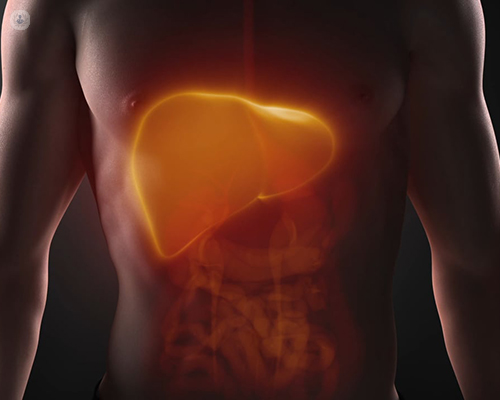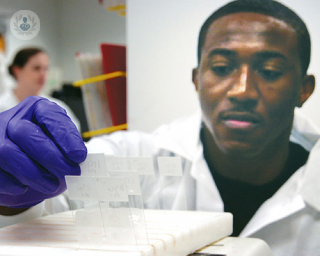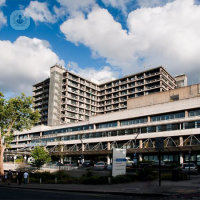Liver biopsy
Dr Matthew Foxton - Hepatology (liver specialist)
Created on: 11-13-2012
Updated on: 10-02-2023
Edited by: Karolyn Judge
What is a liver biopsy?
A liver biopsy is a procedure that is performed to remove a portion of the liver, which will be examined under a microscope to check for signs of damage or disease.

What are the different types of liver biopsy?
There are three main types of biopsy: laparoscopic, percutaneous, and transvenous.
Percutaneous liver biopsy
This is the most commonly-used technique for obtaining a liver sample. It involves making an incision in the abdomen to insert a needle into the liver to take a sample. Ultrasound, CT scans, and other imaging techniques are often used to locate the liver. Some specialists do not use imaging techniques but locate the liver by palpating the abdomen. Once the biopsy is complete, you will have to lie on your left side for up to two hours to reduce the risk of bleeding.
Transvenous liver biopsy
This technique is used if your blood coagulates slowly or if there is excess fluid in the abdomen, a condition known as ascites. With a transvenous biopsy, you lie face up on an X-ray table. A small incision is made in your neck and a tube is inserted into the jugular vein. A contrast dye is then injected to be able to view the veins. This fluid illuminates when X-rays are used. A needle is then inserted through the tube and samples of liver tissue are removed. You will be monitored for at least four to five hours to avoid the risk of bleeding.
Laparoscopic liver biopsy
This type of biopsy is used to obtain a tissue sample from one or more specific areas of the liver, or if there is a risk of infection or cancer spreading. During the test, you will lie on your back and be given a sedative. With laparoscopy, an incision is made in the abdomen, under the rib cage. A tube called a cannula is then inserted and inflated with a gas to give the doctor more space for working in the abdominal cavity. The biopsy needle is inserted through the cannula. Any bleeding can be easily detected with the camera and is stemmed using electric probes. You will be monitored for several hours after the procedure.
The liver is a vital organ that has several basic functions, such as:
- Removing harmful products from the blood
- Fighting infection
- Helping in the digestive process
- Storing energy
- Storing nutrients
Why is a liver biopsy performed?
A liver biopsy is performed when it is difficult to diagnose a possible liver problem with blood tests or by using ultrasound or x-rays.
A biopsy is often performed to assess the degree of liver damage, a process known as staging. Staging helps guide treatment, and the biopsy helps to diagnose or detect:
- Liver cancer
- Infection
- Cause of abnormal liver enzyme levels detected in the blood
- Cause of unexplained thickening of the liver.
How do you prepare for liver biopsy?
The specialist should be fully informed about any medication you are taking, and you may even be asked to stop taking any medication that affects blood clotting or interacts with sedatives.
Some medications that may not be permitted both before or after a liver biopsy are nonsteroidal anti-inflammatory drugs, anticoagulants, antidepressants, antibiotics, dietary supplements and high blood pressure, diabetes and asthma medications.
You must not eat or drink for at least eight hours before the biopsy, and should plan how you will get home, since you must not drive for at least twelve hours after the procedure. Before the procedure, you will need to have a full blood test to check, among other things, your ability to clot blood.
What do you feel during a liver biopsy?
The moment the needle is inserted to sedate you, you will feel a brief, sharp pain. You might feel a deep pain when the biopsy needle is inserted, which sometimes manifests itself in the shoulder.
Sedation helps you to remain calm during the process. Sedation is different to anaesthesia; you are unconscious under anaesthetic, but with sedation you can communicate with the medical team, though you generally won’t remember the procedure afterwards.
What's the meaning of abnormal results?
There are two outcomes from a liver biopsy: either the results are completely normal, which means that the liver tissue is normal, or the liver biopsy reveals the presence of a liver disease, such as hepatitis or cirrhosis, or the presence of cancer cells or infections such as tuberculosis.
Some of the problems that can be detected through a liver biopsy are:
- Hepatitis
- Haemochromatosis
- Hepatocellular carcinoma
- Hodgkin's lymphoma
- Primary biliary cholangitis
- Cirrhosis
- Fatty liver
- Liver cancer
How has the liver biopsy procedure advanced?
The use and advancement of technology has led to a series of changes in general medicine and in the liver biopsy procedure. Major progress has been made in imaging techniques, which are sometimes sufficient to determine the state of the liver.
Another advancement is FibroScan, which measures the speed at which elastic waves are propagated through the liver; this helps to assess the health of the liver.









